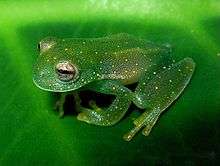Centrolene savagei
Centrolene savagei is a species of frog in the family Centrolenidae that is endemic to the Andes of western Colombia, specifically the Cordillera Occidental and Cordillera Central.[2][3] Its common name is Savage's Cochran frog.[2]
| Centrolene savagei | |
|---|---|
 | |
| Scientific classification | |
| Kingdom: | Animalia |
| Phylum: | Chordata |
| Class: | Amphibia |
| Order: | Anura |
| Family: | Centrolenidae |
| Genus: | Centrolene |
| Species: | C. savagei |
| Binomial name | |
| Centrolene savagei (Ruiz-Carranza and Lynch, 1991) | |
| Synonyms[2] | |
|
Cochranella savagei Ruiz-Carranza and Lynch, 1991 | |
Description
Centrolene savagei is a small glassfrog: adult females measure about 24 mm (0.9 in) in snout–vent length and adult males 20–24 mm (0.8–0.9 in) in snout–vent length,[4][5] It has a wide head with a rounded snout and bulging eyes, and a slender body. The fingers and toes are tipped with adhesive pads. The body and legs are liberally covered with rounded whitish warts. The dorsal surface is bright green speckled with white or pale green, which makes it well-camouflaged on leaves, and the underparts are white and semi-transparent; the bones are green.[6] The species has a number of defenses such as foul-smelling skin secretions and a variety of defensive postures and behaviors.[7]
Reproduction
Adult male Centrolene savagei call at night after there has been rain during the day.[6] The male advertisement call consists of 1–3 "peep" notes, each about 17 milliseconds in length (range 10–22 ms), and separated by silent intervals 302–442 ms in duration.[5] Larger males have lower-pitch calls and higher mating success. Females lay 15–27 cream-coloured eggs on leaves; males can guard the eggs for 24 hours or more.[8] The newly hatched tadpole drop off the leaves into the water below.[6] Tadpoles grow up to 33 mm (1.3 in) in length.[5]
Habitat and conservation
Its natural habitats are sub-Andean[1] and Andean forests at elevations of 1,230–2,050 m (4,000–6,700 ft) above sea level.[3] Its typical habitat is trees and vegetation close to running water.[6] It can also occur in secondary forests. It is currently listed as "Least Concern" on the IUCN Redlist. Its distribution is fragmented and relatively limited in area, and its habitat is lost to agriculture (crops and livestock) and pollution.[1]
References
- IUCN SSC Amphibian Specialist Group. 2017. Centrolene savagei. The IUCN Red List of Threatened Species 2017: e.T54990A63062174. https://dx.doi.org/10.2305/IUCN.UK.2017-3.RLTS.T54990A63062174.en. Downloaded on 08 January 2019.
- Frost, Darrel R. (2017). "Centrolene savagei (Ruiz-Carranza and Lynch, 1991)". Amphibian Species of the World: an Online Reference. Version 6.0. American Museum of Natural History. Retrieved 17 June 2017.
- Acosta Galvis, A. R.; D. Cuentas (2017). "Centrolene savagei (Ruiz-Carranza and Lynch, 1991)". Lista de los Anfibios de Colombia V.07.2017.0. www.batrachia.com. Archived from the original on 4 March 2016. Retrieved 17 June 2017.
- "Centrolene savagei". AmphibiaWeb: Information on amphibian biology and conservation. [web application]. Berkeley, California: AmphibiaWeb. 2014. Retrieved 21 October 2014.
- Díaz-Gutiérrez, N.; Vargas-Salinas, F.; Rivera-Correa, M.; Rojas-Morales, J. N. A. S.; Escobar-Lasso, S.; Velasco, J. N. A.; Gutiérrez-Cárdenas, P. D. A.; Amézquita, A. (2013). "Description of the previously unknown advertisement call and tadpole of the Colombian endemic glassfrog Centrolene savagei (Anura: Centrolenidae)". Zootaxa. 3686 (2): 289–296. doi:10.11646/zootaxa.3686.2.9. PMID 26473219.
- Halliday, Tim (2016). The Book of Frogs: A Life-Size Guide to Six Hundred Species from Around the World. University of Chicago Press. p. 262. ISBN 978-0-226-18465-4.
- Escobar-Lasso, Sergio; Rojas-Morales, Julián Andrés (2012). "Antipredatory behaviors of the Colombian endemic glassfrog Centrolene savagei (Anura: Centrolenidae)". Boletín Científico. Centro de Museos. Museo de Historia Natural. 16 (1): 226–232.
- Vargas-Salinas, F.; Quintero-Ángel, A. S.; Osorio-Domínguez, D.; Rojas-Morales, J. N. A. S.; Escobar-Lasso, S.; Gutiérrez-Cárdenas, P. D. A.; Rivera-Correa, M.; Amézquita, A. (2014). "Breeding and parental behaviour in the glass frog Centrolene savagei (Anura: Centrolenidae)". Journal of Natural History. 48 (27–28): 1689–1705. doi:10.1080/00222933.2013.840942.
